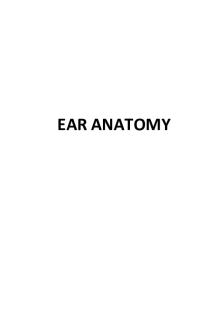19 Ear Continuation - Chapter 19: Ear for Human Anatomy by Mckinley PDF

| Title | 19 Ear Continuation - Chapter 19: Ear for Human Anatomy by Mckinley |
|---|---|
| Course | Human Anatomy |
| Institution | Irvine Valley College |
| Pages | 4 |
| File Size | 89.2 KB |
| File Type | |
| Total Downloads | 49 |
| Total Views | 183 |
Summary
Chapter 19: Ear for Human Anatomy by Mckinley...
Description
EAR ANATOMY
1) External ear- found generally exterior the body -supported by cartilage and covered with skin -Auricle - secure the section into the ear, waves of sound are coordinated by to this to the external auditory canal (bony tube) EAC- protect the ear by avoiding expansive objects from entering and harming tympanic membrane (Eardrum) EAC- ends within the eardrum Eardrum-epithelial tissue between the outside and center e. -vibration occurs as a result of soundwaves Vibrations = sound transmission to the center and internal ear Deep: Ceruminous organs produces cerumen that decrease ear's contamination and avoids bugs (combined with dead swamp skin cells = earwax) 2) Middle Ear- air-filled tympanic cavity is contained here -bony wall houses circular and oval window isolates the center and inner ear Auditory tube-Eustachian tube, pharyngotympanic -open association to atmosphere Air development: chewing, gulping, yawning Auditory Ossicles - by means of the oval window these augment and transmit sound waves >> inner ear by means of the oval window Tympanic Cavity contains 3 littlest bones called AO 1) Malleus- connected to average the center surface of tympanic membrane 2) Incus-middle AO 3)Stapes- fits into the oval window(opening that marks the lateral wall of the internal ear) Stapedius and Tensor tympani muscles that limit movement of AO when uproarious sounds occur -sensitive receptors of the ear are protected 3) Inner Ear-contained in the petrous portion of the temporal bone: Includes the: Bony labyrinth-spaces or cavities; within:
Macula-sensory epi of utricle and saccule foundation -assorted hair cells and supporting cells makes up the macula Hair cells-sensory receptors of inner ear for equilibrium and hearing -release neurotransmitters in a continuous manner Apical surface: stereocilia=microvilli Kinocilium-long cilium of hair cells BENT KINO AND STEREO FOR CHANGES IN AMOUNT OF NEURO Structures and Mechanism of Equilibrium *Detection of the position of the head: Sensory receptors in the utricle and saccule Otoliths or statoconia-small calcium carbonate crystals Statoconic membrane- otoliths and gelatinous membrane *Position of the statoconic membrane is influenced by the head Semicircular canals Three semicircular canals: Anterior, posterior and lateral *Each canals contain semicircular ducts *Rootational movements of the head are detected by receptors in the semicircular ducts detect Ampulla- semicircular duct’s expanded region Crista ampullaris- ampulla’s elevated region composed of hair cells and suppoting cells Cupula- gelatinous dome containing hair cells that are attached to kinocilia and stereocilia Vestibular Sensation Pathways Sensory stimuli for inner ear >> CN VIII >> vestibular nerve >axons project> paired vestibular nuclei medulla oblongata >> motor nuclei in brain stem and spinal cord >> cerebellum, thalamus >> cerebral cortex
Structures for hearing Cochlea- houses earing organs -snail-shaped spiral chamber in the bone of inner ear Modiolus- spongy bone axis
Membranous labyrinth-membrane-lined, fluid-filled tubes and spaces; within Receptors for equilibrium and hearing(sensory epi) Perilymph-fills up the space between the bony labyrinth and membranous labyrinth -similar to extracellular liquid and CSF -tensures the protection of ML Endolymph-ML Bony labyrinth’s Regions: 1) Vestibule-contains two ML (sac-like)= utricle and saccule 2)Semicircular canals- ML: semicircular ducts 3)Cochlea=scala media or cochlear duct Vestibular complex = vestibule and Semicircular canals
Frequency- quantity of waves the move past a point during a specific amount of time (Hz or hertz) Intensity- amount of a resonance’s volume (decibels)
Spiral organ- within modiolus that is responsible for hearing –organ of Corti Scala media- membranous labyrinth that runs through the cochlea Vestibular and basilar membrane- makes up the root and floor of scala media Divided into two smaller chambers: (filled with perilymph) 1) Scala vestibuli- superior chamber 2) Scala tympani- inferior chamber Helicotrema- place where scala vestibuli and scala tympani meet -apex pf the cochlear spiral apex Tectorial membrane- gelatinous structure in which hair cells reach the stereocilia *Pressure waves >> basilar membrane bounces >> alteration of stereocilia
References: McKinley, Michael P., and Valerie Dean. OLoughlin. Human Anatomy. 1st ed., McGraw-Hill Higher Education, 2006....
Similar Free PDFs

Ear exam - Ear examination
- 2 Pages

Inner ear anatomy crossword
- 1 Pages

Ear Meds Administation
- 4 Pages

Ear Irrigation
- 2 Pages

EAR 105 Chapter 6 Questions
- 5 Pages

EAR 105 Chapter 10 Questions
- 4 Pages

EAR 105 Chapter 7 Questions
- 4 Pages

EAR 105 Chapter 12 Questions
- 3 Pages

EAR 105 Chapter 2 Quiz
- 2 Pages

Amk ear notes flashcard
- 2 Pages

Eye and ear disorders
- 9 Pages

EAR 105 Chapter 2 Quiz Notes
- 2 Pages

EAR 105 Chapter 1 quiz Notes
- 2 Pages
Popular Institutions
- Tinajero National High School - Annex
- Politeknik Caltex Riau
- Yokohama City University
- SGT University
- University of Al-Qadisiyah
- Divine Word College of Vigan
- Techniek College Rotterdam
- Universidade de Santiago
- Universiti Teknologi MARA Cawangan Johor Kampus Pasir Gudang
- Poltekkes Kemenkes Yogyakarta
- Baguio City National High School
- Colegio san marcos
- preparatoria uno
- Centro de Bachillerato Tecnológico Industrial y de Servicios No. 107
- Dalian Maritime University
- Quang Trung Secondary School
- Colegio Tecnológico en Informática
- Corporación Regional de Educación Superior
- Grupo CEDVA
- Dar Al Uloom University
- Centro de Estudios Preuniversitarios de la Universidad Nacional de Ingeniería
- 上智大学
- Aakash International School, Nuna Majara
- San Felipe Neri Catholic School
- Kang Chiao International School - New Taipei City
- Misamis Occidental National High School
- Institución Educativa Escuela Normal Juan Ladrilleros
- Kolehiyo ng Pantukan
- Batanes State College
- Instituto Continental
- Sekolah Menengah Kejuruan Kesehatan Kaltara (Tarakan)
- Colegio de La Inmaculada Concepcion - Cebu


